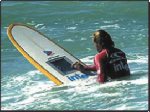


S
c i - Z o n e
By Cracker Jack
<crackjackx@yahoo.com>
 Memorable
Pocket Knife
Memorable
Pocket Knife
If the infinitely handy USB pen-drive has become the Swiss Army knife
of computing, what do you call an actual Swiss Army knife armed with
flash memory? Simple: call it the SwissMemory USB knife, and put it
in every techie's wish list. Recently Victorinox released this nifty
device which includes a blade, a red LED light, a nail file with screwdriver,
scissors, a pen and 64MB of flash storage.
70 mega-pix
Webcam
A quite unknown Swiss company named RoundShot has released an interesting
new item, the 360 internet Livecam. The Livecam is a digital 360 camera,
capable of 70 megapixels. The Swiss company claims the Roundshot Livecam
uses a high-resolution digicam designed for pro-photography, as well
as slit-scan technology, which apparently allows for 'seamless panoramas'
of up to 360 degrees. The cam is also capable of a high zoom factor,
zooming up to 20x. According to the manufacturers, the cam has 'far-reaching"
applications, most importantly in tourism, weather stations, corporate
websites, airports, sports clubs, construction sites and private residences.
Surfing
in a surf-board
 For a decade, "surfing"
has come to mean browsing the net rather than riding ocean waves on
a plank. But a surfboard has now been developed that lets surfers
surf while surfing. The prototype board has been built by Devon "shaper"
Jools Matthews. It houses a laptop, solar panels, and video camera,
and is to launch at the Intel GoldCoast Oceanfest. The world's first
wi-fi board uses a high-speed net connection point - hotspot - positioned
on the beach. Chip makers Intel has commissioned the unusual surfboard
as part of the free sports and music festival in North Devon to show
off how technology can be brought to the sea and sand. The board will
have its maiden outing on the waves when it is used by international
pro surfer Duncan Scott at the event.
For a decade, "surfing"
has come to mean browsing the net rather than riding ocean waves on
a plank. But a surfboard has now been developed that lets surfers
surf while surfing. The prototype board has been built by Devon "shaper"
Jools Matthews. It houses a laptop, solar panels, and video camera,
and is to launch at the Intel GoldCoast Oceanfest. The world's first
wi-fi board uses a high-speed net connection point - hotspot - positioned
on the beach. Chip makers Intel has commissioned the unusual surfboard
as part of the free sports and music festival in North Devon to show
off how technology can be brought to the sea and sand. The board will
have its maiden outing on the waves when it is used by international
pro surfer Duncan Scott at the event.
New Atomic
Particle Found
Scientists at the Department of Energy's Fermi National Accelerator
Laboratory will announce on Friday, June 18 the observation of an
unexpected new member of a family of subatomic particles called "heavy-light"
mesons. The new meson, a combination of a strange quark and a charm
anti-quark, is the heaviest ever observed in this family, and it behaves
in surprising ways -- it apparently breaks the rules on decaying into
other particles. As a rule, the more massive the meson, the shorter
its lifetime before decaying into other particles. But not this time:
this heavy meson lives three times longer than its lighter relatives.
The discovery by the members of the SELEX collaboration uses data
from their fixed-target experiment at Fermilab's Tevatron, the world's
highest-energy particle accelerator. SELEX studies the results of
protons colliding with solid targets of copper and diamond. While
the SELEX experiment stopped taking data in 1997, an extended analysis
revealed this new particle lurking within their data. In the spring
of 2003, experiments at three electron-positron colliders -- BABAR
at Stanford (Cal.) Linear Accelerator Center, CLEO at Cornell University
in New York, and BELLE at KEK in Tsukuba, Japan -- announced the discovery
of a new pair of charm-strange mesons. While these mesons had been
predicted theoretically, their properties didn't match theory. They
had such low masses that they could not decay in the preferred way,
so they had long lifetimes. Following the 2003 announcements, SELEX
began to re-examine its own results to seek out more eta particles
and determine whether they existed in more interesting combinations.
But before any results could be deemed conclusive, the collaboration
had to prove that it understood the unique photon detector well enough
to vouch for that type of data. Several Russian collaborators within
SELEX conducted painstaking tests of the detector, which they had
built; their answer was "yes." The SELEX discovery adds
yet another contradiction to the conventional predictions of meson
behaviour. The known symmetries of heavy-light mesons predict that
other active experiments, such as BABAR, CLEO and BELLE, as well as
Fermilab's FOCUS experiment, will be able to see this particle and
various partner particles in their data, expanding even further our
picture of the strong force, and building on the SELEX result. The
collaboration has submitted a paper describing the result --"First
Observation of a Narrow Charm-Strange Meson DsJ+(2632)->Ds(eta)+
and D0K+" -- to Physical Review Letters. The result was presented
on June 18 in a seminar at Fermilab by physicist Anatoly Evdokimov
of the Institute of Theoretical and Experimental Physics, Moscow,
Russia.
Apple
Making Supercomputer for US Army
Apple Computer Inc. has announce the sale of 1566 dual processor 1U
rack-mount 64-bit Xserve G5 servers to COLSA Corp., which will be
used to build what is expected to be one of the fastest supercomputers
in the world. The US$5.8 million cluster will be used to model the
complex aero-thermodynamics of hypersonic flight for the U.S. Army.
The supercomputer, named MACH 5, is expected to deliver peak performance
capability of more than 25 TFlops/second. In comparison, the Virginia
Tech supercomputer announced last year attained sustained performance
of approximately 10 TFlops/second, according to Apple director of
product management, server hardware, Alex Grossman. With those numbers,
the MACH 5 would rank second only to Japan's $350 million Earth Simulator
computer.
